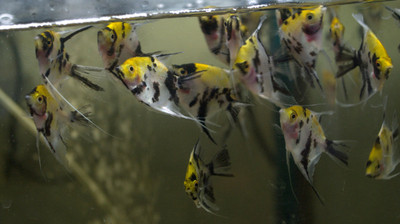Koi Angelfish (Pterophyllum scalare)
Posted by Max Gandara on on 25th Sep 2024
Koi Angelfish (Pterophyllum scalare)
Origin and Habitat:
The Koi Angelfish, scientifically known as Pterophyllum scalare, is a freshwater fish species native to the Amazon Basin in South America. They are commonly found in slow-moving waters, such as rivers, floodplains, and ponds, where they inhabit areas rich in vegetation. Koi Angelfish are bred in captivity, leading to various color morphs, including the striking Koi pattern, which resembles the traditional Koi carp found in ponds.
Appearance:
Koi Angelfish are renowned for their stunning appearance. They typically exhibit a combination of white, orange, and black colors, resembling the popular Koi carp. Their bodies are triangular, and their long, flowing fins add grace and elegance to their swimming. Adult Koi Angelfish can reach sizes of about 6 to 8 inches (15 to 20 cm) in height and have a lifespan of 10 years or more with proper care.
Aquarium Care:
Caring for Koi Angelfish is relatively straightforward, making them suitable for both beginner and experienced aquarists. However, they do require specific conditions to thrive.
- Tank Size: A minimum tank size of 20 gallons is recommended for a pair of Koi Angelfish. Larger tanks (30 gallons or more) are ideal, especially if keeping a small group or adding other species to the community tank.
- Water Parameters: Koi Angelfish thrive in warm water, with temperatures ranging from 75°F to 82°F (24°C to 28°C) and a pH level of 6.5 to 7.5. They prefer slightly acidic to neutral water conditions. Regular water changes and a good filtration system are essential to maintain water quality.
- Diet: These fish are omnivores and enjoy a varied diet. High-quality flake food, pellets, and live or frozen foods such as brine shrimp, bloodworms, and daphnia will help keep them healthy and vibrant. Incorporating some vegetable matter, such as spirulina flakes, can also benefit their overall nutrition.
- Behavior and Temperament: Koi Angelfish are generally peaceful but can become territorial, especially during breeding. It’s best to keep them in pairs or small groups, ensuring there is enough space and hiding spots to reduce aggression. Suitable tank mates include other peaceful species such as tetras, gouramis, and smaller cichlids.
Aquarium Setup:
To create a suitable environment for Koi Angelfish, the aquarium should be well-planted with plenty of hiding spots using driftwood, rocks, and tall plants. They appreciate an environment that mimics their natural habitat, so incorporating floating plants can provide shelter and cover. A soft substrate will allow them to explore and forage naturally. Maintain good water circulation while avoiding strong currents, as Angelfish prefer calmer waters.
Breeding:
Breeding Koi Angelfish can be a rewarding experience, as they are known to be attentive parents. To encourage spawning, a separate breeding tank is recommended with flat surfaces or spawning slates. Males will display courtship behavior, including showing off their colors and swimming in circles around the female. After laying eggs, both parents will guard the eggs until they hatch, which typically occurs within 2 to 3 days. The fry can be fed infusoria or finely crushed flake food once they become free-swimming.
Lifespan:
With proper care, Koi Angelfish can live for 10 years or more. Maintaining stable water conditions, providing a balanced diet, and ensuring a stress-free environment are crucial for their longevity.
Conclusion:
The Koi Angelfish is a breathtaking addition to any freshwater aquarium, known for its vibrant colors and graceful presence. While their territorial nature requires some care in selecting tank mates, their beauty and engaging behavior make them a favorite among aquarists. With the right care and environment, Koi Angelfish can thrive and provide years of enjoyment in a well-maintained aquarium.

